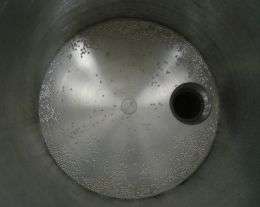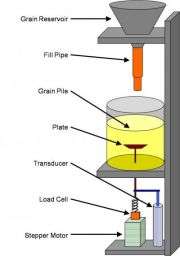Physicists Find that Size Matters When Initiating an Object's Movement Through Grains

A team of Penn State physicists has discovered that the size of grains, such as sand, above a buried object is important in determining the force required to begin raising the object. No one, until now, has discovered how much force is required to initiate an object's movement through grains. The result may be useful for engineering foundations for objects to be anchored in sandy soils, such as power-line towers, or for designing industrial mixer blades, such as those used in pharmaceutical processing. The team's paper is published this month in the journal Physical Review Letters.
"We found that less force is needed to lift an object that is buried beneath small grains than is needed to lift an object that is buried beneath larger grains," said Peter Schiffer, associate vice president for research and a professor of physics at Penn State. "Basically, if you are buried alive and you have to push open a coffin lid, it's better to be buried under fine-grained sand than under pebbles," he said.

According to Schiffer, other researchers have examined how much force is required to maintain an object's movement through grains, but no one previously had looked at how much force is required to initiate it. "The two measurements are different," he said. "When initiating the movement of an object, the grains immediately above the object must be shifted out of the way to make space for the object to move, which requires that the surrounding grains be loosened. In contrast, an object that already is in motion requires less force to maintain that motion because the surrounding grains already are loosened. It's the loosening of grains around the object that seems to make the difference," said Schiffer.
The scientists built an apparatus that measures the force required to push a flat circular plate upward from the bottom of a cylindrical bucket that is filled with glass beads. The team measured the force using different sizes of glass beads and found that the smallest beads required the least amount of force to lift the plate. "The total weight of the grains above the plate was adjusted so that it was the same regardless of grain size," said Dan Costantino, a Penn State graduate student and one of the paper's lead authors.
In the future, the team plans to measure the force required to initiate the horizontal movement of an object through grains. The scientists also plan to substitute water or a heavy liquid for the air between the grains. "A liquid that has the same density as the grains will effectively make the grains weightless, so we can further investigate whether the strength of the grains comes from their weight or from the way they are packaged together," said Costantino.
Source: Penn State





















